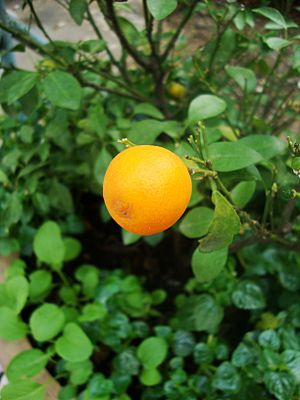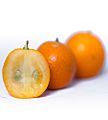Kumquat facts for kids
Quick facts for kids Kumquat |
|
|---|---|
 |
|
| Malayan Kumquat foliage and fruit | |
| Scientific classification | |
| Kingdom: | |
| Division: | |
| Class: | |
| Order: | |
| Family: | |
| Genus: | |
The kumquats or cumquats are a group of small fruit-bearing trees. The edible fruit closely resembles the orange in color and shape but is much smaller, being approximately the size of a large olive. They are more capable of enduring difficult conditions than citrus plants such as oranges.
The kumquat plant is native to south Asia and the Asia-Pacific region. The earliest historical reference to kumquats appears in literature of China from the 12th century. They have long been cultivated in India, Japan, Taiwan, the Philippines, and southeast Asia. They were introduced to Europe in 1846 by Robert Fortune, collector for the London Horticultural Society, and shortly thereafter were brought to North America.
Description
Kumquats are slow-growing, evergreen shrubs or small trees, from 2.5–4.5 m tall, with dense branches. Sometimes they have small thorns. The leaves are dark glossy green, and the flowers pure white, similar to citrus flowers.
The 'Nagami' kumquat needs a hot summer, ranging from 25 °C(77°F) to 38°C(100.4°F), but can withstand frost down to about -10 °C(14°F). It grows in the tea regions of China where the climate is too cold for other citrus fruits.
Kumquats do not grow well from seeds and so are vegetatively propagated by using rootstock of another citrus fruit, air layering, or cuttings (using a rooting gel/powder). Like most citrus, they are self-pollinating.
Images for kids
-
Round kumquats (or citrofortunella)
-
Round kumquats (or citrofortunella)
-
Potted kumquat trees at a kumquat liqueur distillery in Corfu.
-
Slices of kumquat pie at the Kumquat Festival in Dade City, Florida
-
Kumquat preserves
See also
 In Spanish: Kumquat para niños
In Spanish: Kumquat para niños




















